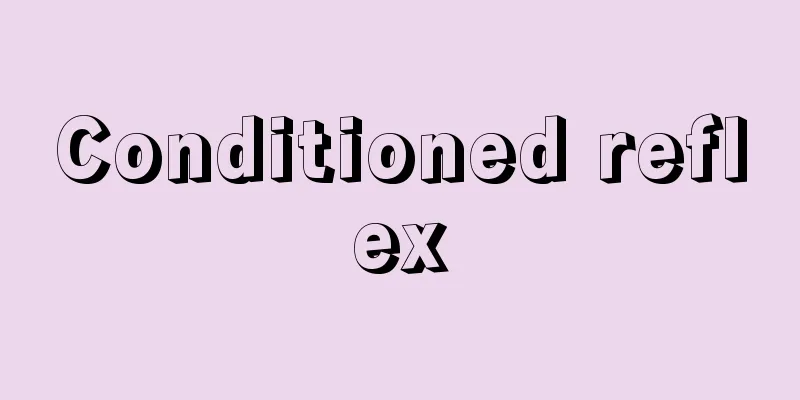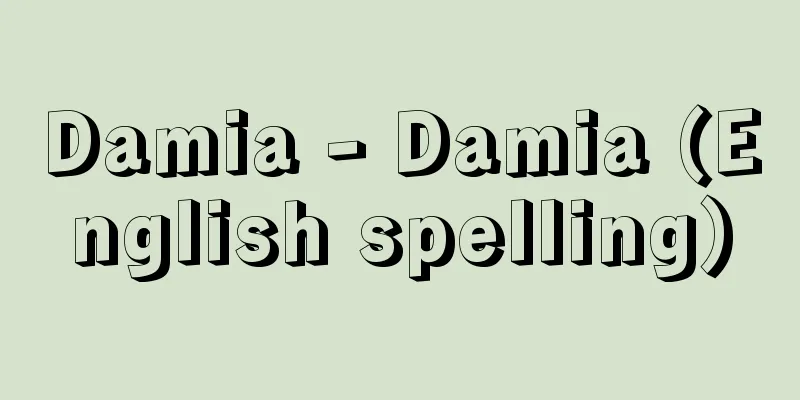Conditioned reflex

|
A conditioned reflex is a reflex acquired later in life, as opposed to a reflex that is innate. Conditioned reflexes were developed by the Russian physiologist Pavlov as a research tool for cerebral physiology. When a dog is given food, it secretes saliva, and this reflex is innate and is called an "unconditioned reflex." On the other hand, if a dog is repeatedly given food while playing a certain sound, it will begin to secrete saliva just by playing the sound. Originally, sound and the secretion of saliva are unrelated, but a new reflex has been formed in which saliva is secreted by playing the sound, and this is called a "conditioned reflex." In this case, the sound is called the "conditioned stimulus," and the thing that causes the unconditioned reflex, such as food, is called the "unconditioned stimulus." The process of causing a reflex through a conditioned stimulus is called "conditioning," and the formation of a passive conditioned reflex in response to a given stimulus, as in this example, is called "classical conditioning." The above is Pavlov's conditioned reflex, but the American psychologist Skinner noticed that when rats were given food only if they pressed a lever, they learned to press the lever to get food. This type of condition, in which a rat actively responds to environmental conditions, is called "instrumental conditioning" or "operant conditioning" as opposed to "classical conditioning." [Torii Shizuo] The nature of conditioned reflexes(1) Generalization: When a conditioned reflex is formed in response to a certain conditioned stimulus (for example, a 1000 Hz sound), the animal will also react to a similar stimulus (for example, an 800 Hz sound). This phenomenon is called generalization. (2) Differentiation: If an animal is repeatedly given food when it hears a 1000 Hz sound and not given food when it hears a 500 Hz sound, saliva will be secreted when it hears the former sound, but not when it hears the latter sound. This phenomenon is called differentiation. (3) Inhibition: If a strong stimulus is suddenly given at the same time as the conditioned stimulus, the conditioned reflex will not occur. This is called external inhibition. In some cases, a process of suppressing a conditioned reflex may naturally form in the animal's brain. This is called internal inhibition. For example, if an unconditioned stimulus is given at the same time as the conditioned stimulus (this is called reinforcement), and after the conditioned reflex is formed, the conditioned reflex will not occur if the conditioned stimulus is continued to be given without reinforcement. This is called extinction. However, in this case, the conditioned reflex occurs when the conditioned stimulus is applied again after a considerable time has passed, so it is thought that the conditioned stimulus repeated in a short period of time temporarily caused internal inhibition. Also, if there is a time between the conditioned stimulus and the unconditioned stimulus, the latency of the conditioned reflex is extended. This is called a delayed conditioned reflex. During the latency period, strong internal inhibition occurs, and when it becomes severe, sleep occurs. [Torii Shizuo] Mechanism of conditioned reflexesPavlov believed that conditioned reflexes are formed by the establishment of new connections in the cerebral cortex. For example, if you turn on a light every time you give a dog food, saliva will be secreted just by turning on the light, even without giving food. The process of the formation of a conditioned reflex in this case can be modeled as follows: the light acts on the eyes, stimulating the visual center in the occipital lobe of the cerebral cortex. On the other hand, food acts on the tongue, stimulating the salivary secretion center in the brain stem, which sends a command to the salivary glands and at the same time excites the taste center in the cerebral cortex. When these processes are repeated at the same time, new connections are established between the visual center and taste center in the cerebral cortex. In other words, the action of the light is transmitted from the visual center of the cerebral cortex via the taste center to the salivary secretion center in the brain stem, and from there the same command as in the case of an unconditioned reflex is sent to the salivary glands. It can be inferred from everyday experience that such mechanisms occur as needed not only in the cerebral cortex but also between each part of the cerebral cortex. These functions of the brain are not fixed but can change, a phenomenon known as plasticity. Research into conditioned reflexes can be said to be an exploration of the laws of plasticity. Pavlov divided conditioned reflexes into the first and second signaling systems, calling the conditioned reflexes seen in animals based on direct experience the first signaling system, and the verbal conditioned reflexes that are learned indirectly through words without direct experience the second signaling system. Humans can communicate the experiences they have acquired to others by using the second signaling system. Movies, plays, literary works, etc. can be said to evoke emotional responses and make an impression through the second signaling system. [Torii Shizuo] Experimental NeurosisIf a dog is trained to be given food when it is shown a circle as a conditioned stimulus and not given food when it is shown an ellipse, and the ellipse is gradually made closer to a circle, it will eventually be unable to distinguish between a circle and an ellipse and will become confused. The dog's behavior will suddenly change, and whether it is shown a circle or an ellipse, it will salivate in an attempt to escape the stimulus, making it impossible to continue any further experiments. This state is called experimental neurosis, and is caused by a conflict between the neural processes of excitation and inhibition. [Torii Shizuo] [References] | | |After performing surgery on dogs so that he could measure the amount of saliva secreted, Pavlov used a device like the one shown in the figure to conduct experiments on "conditioned reflexes." By repeatedly playing a bell and then giving a small amount of food to a dog, the dog eventually begins to secrete saliva at the sound of the bell alone. In the figure, the dog's saliva is transported through a tube to a beaker, and the movement of the valve on the beaker is transmitted to an external recorder, which records the secretion response. When a passive conditioned reflex is formed in response to a given stimulus in this way, it is called "classical conditioning. " Classical conditioning apparatus Skinner placed rats in a device like the one shown in the figure, and gave them food only when they pressed a lever. Eventually, the rats learned to press the lever to get food. This type of active response to environmental conditions is called "instrumental conditioning" or "operant conditioning. " Instrumental conditioning (operant conditioning)… Source: Shogakukan Encyclopedia Nipponica About Encyclopedia Nipponica Information | Legend |
|
生まれつき備わっている反射に対して、後天的に獲得する反射をいう。条件反射は、ロシアの生理学者パブロフが大脳生理学の研究手段として開発したものである。イヌに食物を与えると唾液(だえき)の分泌がおこるが、このような反射は生まれつきのものであり、「無条件反射」とよばれる。一方、イヌに一定の音を聞かせながら食物を与えることを繰り返すと、音を聞かせただけで唾液が分泌されるようになる。本来、音と唾液の分泌とは無関係なものであるが、音を聞かせることによって唾液が分泌されるという新しい反射が形成されたわけであり、これを「条件反射」という。この場合、音を「条件刺激」とよび、食物のような無条件反射の原因となるものを「無条件刺激」という。また、条件刺激によって反射がおこるようにすることを「条件づけ」といい、この例のように、与えられた刺激に対して受動的な条件反射が形成される場合を「古典的条件づけ」という。以上がパブロフの条件反射であるが、これに対して、アメリカの心理学者スキナーは、ネズミがレバーを押した場合にのみ餌(えさ)を与えるようにすると、レバーを押して餌を手に入れることを習得することに着目した。このように、積極的に環境条件に対応するようになる場合を、「古典的条件づけ」に対して「道具的条件づけ」または「オペラント条件づけ」という。 [鳥居鎮夫] 条件反射の性質(1)汎化(はんか) ある条件刺激(たとえば1000ヘルツの音)に対して条件反射が形成されると、それに類似した刺激(たとえば800ヘルツの音)に対しても反応をおこすようになる。この現象を汎化という。(2)分化 1000ヘルツの音を聞かせたときは餌を与え、500ヘルツの音を聞かせたときは餌を与えないという操作を繰り返すと、前者の音を聞くと唾液は分泌されるが、後者の音では唾液が分泌されないようになる。この現象を分化という。(3)制止 条件刺激と同時に、突然他の強い刺激を与えると条件反射がおこらなくなる。これを外制止という。また条件反射を抑制する過程が動物の脳の中で自然に形成されていく場合がある。これを内制止という。たとえば、条件刺激とともに無条件刺激を同時に与えて(これを強化という)、条件反射を形成したあと、強化せずに条件刺激のみを引き続き繰り返すと、条件反射がおこらなくなる。これを消去という。しかし、この場合はかなりの時間を経てふたたび条件刺激を与えると条件反射がおこることから、短時間に繰り返された条件刺激が一時的に内制止を引き起こしたと考えられる。また、条件刺激と無条件刺激との間に時間を置くと条件反射の潜時が延びる。これを延滞条件反射という。潜時中は強い内制止が発生し、それが高度になると睡眠がおこる。 [鳥居鎮夫] 条件反射のメカニズムパブロフは、条件反射は大脳皮質に新しい結合が成立することによって形成されると考えた。たとえば、イヌに食物を与えるたびに電灯をつけると、電灯をつけるだけで食物を与えなくても唾液分泌がおこるが、この場合の条件反射の形成過程は次のように模式化できる。電灯は目に作用し、大脳皮質後頭葉の視覚中枢を興奮させる。他方、餌は舌に作用して脳幹の唾液分泌の中枢を興奮させて、唾液腺(せん)へ指令を送ると同時に、大脳皮質の味覚中枢をも興奮させる。これらの過程が同時に繰り返しおこっていると、大脳皮質の視覚中枢と味覚中枢との間に新しい結合が成立することとなる。つまり、電灯の作用は大脳皮質の視覚中枢から味覚中枢を経由して、脳幹の唾液分泌中枢に伝えられ、そこから無条件反射の場合と同じような指令が唾液腺に行くようになるというわけである。このようなメカニズムは、大脳皮質ばかりでなく、大脳の各部分の間に必要に応じて生ずることは、日常の経験からも推察しうることである。こうした大脳の機能は固定されたものではなく、変化しうるものであり、これを可塑性とよんでいる。条件反射の研究はこの可塑性に関する法則を追究するものであるといえよう。 パブロフは条件反射を第一および第二信号系に分け、動物にみられる直接経験による条件反射を第一信号系、直接に経験しないことでもことばによって間接的に学習する言語条件反射を第二信号系とよんだ。ヒトは第二信号系を用いることによって、個人が獲得した経験を他人に伝えることができるわけである。映画、演劇、文学作品などは第二信号系によって情緒反応をおこし、感銘を与えるということができる。 [鳥居鎮夫] 実験神経症イヌに条件刺激として円を見せたときに餌を与え、楕円(だえん)を見せたときは餌を与えないように訓練し、しだいに楕円を円に近づけていくと、やがて円と楕円の区別ができなくなり、混乱がおこる。イヌの行動は突然変化し、円を見せても楕円を見せても唾液を流して刺激から逃れようとするため、それ以上の実験はできなくなる。このような状態を実験神経症といい、興奮と抑制の神経過程の衝突によって引き起こされるものである。 [鳥居鎮夫] [参照項目] | | |パブロフは、唾液の分泌量を計測できるよう、イヌに手術を施したあと、図のような装置を用いて「条件反射」の実験を行った。イヌにベルの音を聞かせたあと少量の餌を与えるという操作を繰り返すと、やがてベルの音だけで唾液分泌がおこる。図では、イヌの唾液はチューブを通じてビーカーに運ばれるが、その際、ビーカー上の弁の動きは外部に置かれた記録計に伝達され、分泌反応が記録される。このように、与えられた刺激に対して受動的な条件反射が形成される場合を「古典的条件づけ」という©Shogakukan"> 古典的条件づけの装置 スキナーは、図のような装置にネズミを入れ、レバーを押したときにのみ餌を与えるようにした。やがて、ネズミはレバーを押して餌を得ることを学ぶようになる。このように、積極的に環境条件に対応する場合を「道具的条件づけ」または「オペラント条件づけ」という©Shogakukan"> 道具的条件づけ(オペラント条件づけ)の… 出典 小学館 日本大百科全書(ニッポニカ)日本大百科全書(ニッポニカ)について 情報 | 凡例 |
>>: Securities and Exchange Law
Recommend
Manchurian baccata (English spelling)
… [Mitsuru Hotta]... *Some of the terminology tha...
Aldrichina grahami (English spelling) Aldrichinagrahami
...They emerge from animal carcasses (rotten fish...
Narita [city] - Narita
A city in northern Chiba Prefecture. It was incorp...
Geriatric care - roujiniryo
Medical care that takes into account the physical,...
Opium alkaloid scopolamine injection - opium alkaloid scopolamine injection
...Side effects vary widely from person to person...
Poetry - English
Introduction It is commonly believed that poetry ...
Rosario (English spelling)
A city in the southeastern part of Santa Fe Provin...
Ibn al-Amid
…Born in Cairo and died in Damascus. Known as Ibn...
capers
Capparis spinosa is a shrub of the Capparaceae fam...
Seal Saint - Insei
…He excelled in calligraphy and landscape paintin...
Borovsky, KH (English spelling) BorovskyKH
…A Central European republic that existed from 19...
Ratsiraka, D. (English spelling) RatsirakaD
...In February 1975, a conflict broke out within ...
Mount Jinhua (China)
...After that, the name was changed to Jinhua Cou...
Mitsui O.S.K. Lines, Ltd.
The shipping company (English name Mitsui OSK Line...
Hadley, J.
…It was based on the same optical principles as t...

![Albergo (English spelling) [Italy]](/upload/images/67cadf5572457.webp)






![Volvo [company] - Volvo](/upload/images/67ccdea5dbe89.webp)
